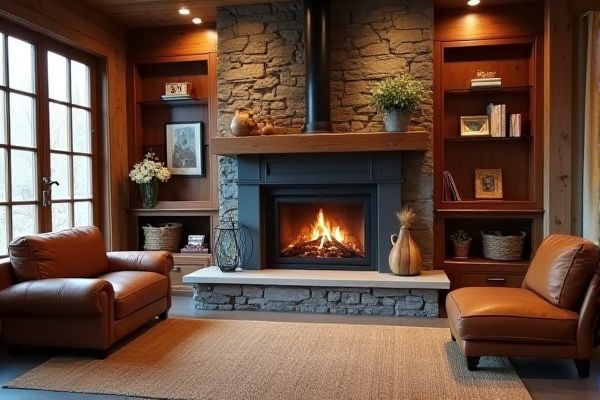
A wood burning stove offers a cozy, traditional heat source with a distinct crackling ambiance, while a gas fireplace provides convenient, clean-burning warmth with easy temperature control, making each ideal depending on your basement setup and maintenance preferences. Discover which option best suits your home's needs by reading the full comparison in the rest of the article.
Table of Comparison
| Feature | Wood Burning Stove | Gas Fireplace |
|---|---|---|
| Fuel Source | Wood logs | Natural gas or propane |
| Installation Cost | Moderate to high | Moderate |
| Operating Cost | Low (wood prices vary) | Medium (gas utility bills) |
| Heat Output | High, radiant heat | Consistent, adjustable heat |
| Maintenance | Regular cleaning, ash removal | Minimal, occasional inspection |
| Environmental Impact | Emits smoke and particulates | Cleaner combustion, lower emissions |
| Ventilation Requirements | Chimney or flue needed | Direct vent or vent-free options |
| Ease of Use | Requires manual fueling and tending | Simple ignition, remote controls available |
| Safety | Higher risk if not maintained properly | Safer with automatic shut-off features |
| Aesthetic | Traditional, rustic appearance | Modern designs, customizable |
Introduction: Comparing Basement Heating Options
Wood burning stoves provide a traditional, cost-effective heating solution with high heat output and a cozy ambiance, ideal for basements where ventilation can be managed properly. Gas fireplaces offer cleaner combustion, lower maintenance, and convenient temperature control, making them a safer choice in confined basement spaces. Your decision hinges on balancing installation requirements, fuel availability, and desired aesthetics for efficient basement heating.
Energy Efficiency: Wood Burning Stove vs Gas Fireplace
Wood burning stoves typically offer higher energy efficiency in basements by directly radiating heat into the space, achieving around 70-80% efficiency. Gas fireplaces, while convenient and cleaner-burning, generally convert only 60-70% of fuel energy into heat. Your choice between these options should consider both energy savings and operational convenience in a basement setting.
Installation Requirements and Costs
Wood burning stoves require a chimney or flue system for proper ventilation, often increasing installation complexity and cost, especially in basements without existing vents. Gas fireplaces typically need a direct vent system, which can be easier and less expensive to install in a basement due to their flexibility in vent placement. Your choice impacts upfront installation expenses and long-term maintenance costs, with wood stoves generally incurring higher costs due to chimney construction and safety requirements.
Heat Output and Distribution
Wood burning stoves deliver intense radiant heat, warming your basement quickly with high BTU output, but heat distribution can be uneven, often requiring additional fans for airflow. Gas fireplaces offer consistent heat output with adjustable settings and typically provide better heat distribution through built-in blowers, ensuring even warmth throughout the space. Choosing the right option depends on your preference for heat intensity versus convenience and uniform temperature control.
Safety Considerations for Basements
Wood burning stoves require proper ventilation and regular chimney cleaning to prevent creosote buildup, reducing fire hazards in basements. Gas fireplaces offer a safer alternative with sealed combustion systems that minimize carbon monoxide risks and eliminate the need for venting through the living space. Ensuring functional smoke and carbon monoxide detectors in your basement is essential regardless of your heating choice to protect your home and family.
Maintenance and Cleaning Needs
Wood burning stoves require regular cleaning of ash and soot buildup, along with periodic chimney inspections to prevent creosote fires. Gas fireplaces offer easier maintenance with occasional inspections of gas lines and venting systems to ensure safe operation. Choosing between the two depends on the homeowner's willingness to perform more intensive upkeep versus minimal routine checks.
Environmental Impact and Emissions
Wood burning stoves produce higher particulate emissions and carbon monoxide compared to gas fireplaces, contributing more to air pollution and indoor air quality concerns in your basement. Gas fireplaces emit fewer greenhouse gases and burns cleaner, making them a more environmentally friendly option with reduced impact on climate change. Choosing a gas fireplace can significantly lower your carbon footprint while maintaining efficient heating in confined basement spaces.
Aesthetic Appeal and Customization
Wood burning stoves offer a rustic and authentic aesthetic appeal with the natural flicker and crackle of burning logs, enhancing the cozy ambiance of basement spaces. Gas fireplaces provide sleek, modern designs with adjustable flame settings and customizable front panels, allowing homeowners to tailor the look to their decor style. Both options can be integrated with various mantels, surrounds, and finishes to complement the basement's overall interior design.
Convenience and User Experience
Wood burning stoves require regular maintenance such as ash removal and chimney cleaning but offer a traditional ambiance and strong, consistent heat output ideal for large basements. Gas fireplaces provide superior convenience with instant ignition, adjustable flame control, and minimal upkeep, making them user-friendly for quick warmth and ambiance. For basement settings, gas fireplaces often excel in user experience by combining efficient heating with modern technology and cleaner operation.
Final Verdict: Choosing the Best for Your Basement
Wood burning stoves provide authentic heat and a rustic ambiance ideal for basement settings, while gas fireplaces offer cleaner operation and easier maintenance. Your choice hinges on preferences for installation complexity, fuel availability, and environmental impact, with wood stoves requiring venting and regular cleaning compared to the convenience of gas models. Evaluate your basement's ventilation, usage frequency, and aesthetic goals to determine the best heating solution for comfort and efficiency.
 homyna.com
homyna.com